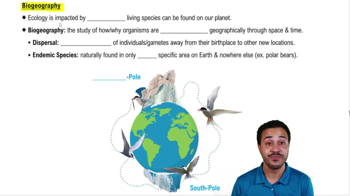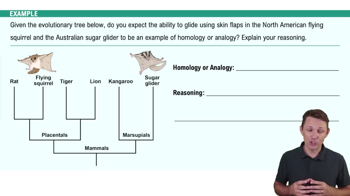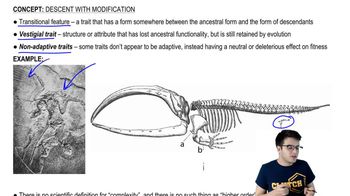Table of contents
- 1. Introduction to Biology2h 42m
- 2. Chemistry3h 40m
- 3. Water1h 26m
- 4. Biomolecules2h 23m
- 5. Cell Components2h 26m
- 6. The Membrane2h 31m
- 7. Energy and Metabolism2h 0m
- 8. Respiration2h 40m
- 9. Photosynthesis2h 49m
- 10. Cell Signaling59m
- 11. Cell Division2h 47m
- 12. Meiosis2h 0m
- 13. Mendelian Genetics4h 44m
- Introduction to Mendel's Experiments7m
- Genotype vs. Phenotype17m
- Punnett Squares13m
- Mendel's Experiments26m
- Mendel's Laws18m
- Monohybrid Crosses19m
- Test Crosses14m
- Dihybrid Crosses20m
- Punnett Square Probability26m
- Incomplete Dominance vs. Codominance20m
- Epistasis7m
- Non-Mendelian Genetics12m
- Pedigrees6m
- Autosomal Inheritance21m
- Sex-Linked Inheritance43m
- X-Inactivation9m
- 14. DNA Synthesis2h 27m
- 15. Gene Expression3h 20m
- 16. Regulation of Expression3h 31m
- Introduction to Regulation of Gene Expression13m
- Prokaryotic Gene Regulation via Operons27m
- The Lac Operon21m
- Glucose's Impact on Lac Operon25m
- The Trp Operon20m
- Review of the Lac Operon & Trp Operon11m
- Introduction to Eukaryotic Gene Regulation9m
- Eukaryotic Chromatin Modifications16m
- Eukaryotic Transcriptional Control22m
- Eukaryotic Post-Transcriptional Regulation28m
- Eukaryotic Post-Translational Regulation13m
- 17. Viruses37m
- 18. Biotechnology2h 58m
- 19. Genomics17m
- 20. Development1h 5m
- 21. Evolution3h 1m
- 22. Evolution of Populations3h 52m
- 23. Speciation1h 37m
- 24. History of Life on Earth2h 6m
- 25. Phylogeny2h 31m
- 26. Prokaryotes4h 59m
- 27. Protists1h 12m
- 28. Plants1h 22m
- 29. Fungi36m
- 30. Overview of Animals34m
- 31. Invertebrates1h 2m
- 32. Vertebrates50m
- 33. Plant Anatomy1h 3m
- 34. Vascular Plant Transport1h 2m
- 35. Soil37m
- 36. Plant Reproduction47m
- 37. Plant Sensation and Response1h 9m
- 38. Animal Form and Function1h 19m
- 39. Digestive System1h 10m
- 40. Circulatory System1h 57m
- 41. Immune System1h 12m
- 42. Osmoregulation and Excretion50m
- 43. Endocrine System1h 4m
- 44. Animal Reproduction1h 2m
- 45. Nervous System1h 55m
- 46. Sensory Systems46m
- 47. Muscle Systems23m
- 48. Ecology3h 11m
- Introduction to Ecology20m
- Biogeography14m
- Earth's Climate Patterns50m
- Introduction to Terrestrial Biomes10m
- Terrestrial Biomes: Near Equator13m
- Terrestrial Biomes: Temperate Regions10m
- Terrestrial Biomes: Northern Regions15m
- Introduction to Aquatic Biomes27m
- Freshwater Aquatic Biomes14m
- Marine Aquatic Biomes13m
- 49. Animal Behavior28m
- 50. Population Ecology3h 41m
- Introduction to Population Ecology28m
- Population Sampling Methods23m
- Life History12m
- Population Demography17m
- Factors Limiting Population Growth14m
- Introduction to Population Growth Models22m
- Linear Population Growth6m
- Exponential Population Growth29m
- Logistic Population Growth32m
- r/K Selection10m
- The Human Population22m
- 51. Community Ecology2h 46m
- Introduction to Community Ecology2m
- Introduction to Community Interactions9m
- Community Interactions: Competition (-/-)38m
- Community Interactions: Exploitation (+/-)23m
- Community Interactions: Mutualism (+/+) & Commensalism (+/0)9m
- Community Structure35m
- Community Dynamics26m
- Geographic Impact on Communities21m
- 52. Ecosystems2h 36m
- 53. Conservation Biology24m
21. Evolution
Introduction to Evolution and Natural Selection
Problem 7`
Textbook Question
Marsupial mammals give birth to young that complete their development in a pouch on the mother's abdomen. All the native mammals of Australia are marsupials, while these types of mammals are absent or uncommon on other continents. This observation is an example of
a. Developmental evidence for evolution
b. Biogeographic evidence for evolution
c. Genetic evidence for evolution
d. Fossil evidence for evolution
e. Not useful evidence for evolution
 Verified step by step guidance
Verified step by step guidance1
Step 1: Begin by understanding the concept of evolution and the types of evidence that support it. Evolution is the process by which species change over time through mechanisms like natural selection, genetic drift, and mutation. Evidence for evolution can come from various fields, including biogeography, genetics, fossils, and developmental biology.
Step 2: Analyze the problem statement. It mentions that marsupial mammals are native to Australia and are uncommon or absent on other continents. This distribution pattern of species is a key clue in determining the type of evidence being described.
Step 3: Recall the definition of biogeographic evidence for evolution. Biogeography is the study of the geographic distribution of species and ecosystems. It provides evidence for evolution by showing how species have adapted to different environments and how geographic isolation can lead to speciation.
Step 4: Compare the other options provided in the question. Developmental evidence refers to similarities in embryonic development across species. Genetic evidence involves DNA and molecular similarities. Fossil evidence involves remains or imprints of organisms from the past. None of these directly address the geographic distribution of species.
Step 5: Conclude that the observation of marsupials being native to Australia and uncommon elsewhere is an example of biogeographic evidence for evolution, as it highlights how geographic isolation has influenced the distribution and evolution of species.
 Verified video answer for a similar problem:
Verified video answer for a similar problem:This video solution was recommended by our tutors as helpful for the problem above
Video duration:
1mPlay a video:
Was this helpful?
Key Concepts
Here are the essential concepts you must grasp in order to answer the question correctly.
Marsupial Reproduction
Marsupial mammals, such as kangaroos and koalas, give birth to relatively undeveloped young that continue their growth in a pouch. This unique reproductive strategy allows for a shorter gestation period and provides a safe environment for the young to develop while being nourished by the mother.
Recommended video:
Guided course

Fungi Reproduction - 3
Biogeography
Biogeography is the study of the distribution of species and ecosystems in geographic space and through geological time. It helps explain why certain species, like marsupials, are predominantly found in specific regions, such as Australia, and how geographical barriers influence evolutionary processes.
Recommended video:
Guided course

Biogeography
Evidence for Evolution
Evidence for evolution includes various types of data that support the theory of evolution, such as developmental, biogeographic, genetic, and fossil evidence. In this context, the unique presence of marsupials in Australia serves as biogeographic evidence, illustrating how species adapt and evolve in response to their environments.
Recommended video:

Evidence of Evolution Example 1

 4:58m
4:58mWatch next
Master Evolution and Natural Selection with a bite sized video explanation from Jason
Start learningRelated Videos
Related Practice
































